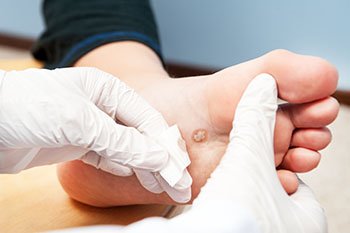Connect With Us
Blog
Items filtered by date: March 2023
Working Out With Broken Feet

When someone breaks or fractures their feet, it can significantly limit their motion and mobility. Therefore, many patients often wonder how they can perform daily exercise routines while suffering from a broken foot. It is important to always listen to the advice of your trusted medical professional, such as a podiatrist, who can tell you what activities are still permissible. For example, your podiatrist might tell you that if your condition is not too severe, swimming might be a permissible activity to engage in. Also, your podiatrist might inform you that core-strengthening exercises that do not put pressure on your feet can still be performed. If you have a broken foot and want to learn more about your exercise options, it is suggested that you schedule an appointment with a podiatrist today.
Exercising your feet regularly with the proper foot wear is a great way to prevent injuries and build strength. If you have any concerns about your feet, contact Eugene Little, DPM from Foot and Ankle Centers of Ohio. Our doctor can provide the care you need to keep you pain-free and on your feet.
Exercise for Your Feet
Exercise for your feet can help you gain strength, mobility and flexibility in your feet. They say that strengthening your feet can be just as rewarding as strengthening another part of the body. Your feet are very important, and we often forget about them in our daily tasks. But it is because of our feet that are we able to get going and do what we need to. For those of us fortunate enough to not have any foot problems, it is an important gesture to take care of them to ensure good health in the long run.
Some foot health exercises can include ankle pumps, tip-toeing, toe rises, lifting off the floor doing reps and sets, and flexing the toes. It is best to speak with Our doctor to determine an appropriate regimen for your needs. Everyone’s needs and bodies are different, and the activities required to maintain strength in the feet vary from individual to individual.
Once you get into a routine of doing regular exercise, you may notice a difference in your feet and how strong they may become.
If you have any questions please feel free to contact our office located in Sidney, OH . We offer the newest diagnostic and treatment technologies for all your foot and ankle needs.
Plantar Fasciitis and Yoga

Plantar fasciitis occurs when the band of tissue that runs along the arch of the foot becomes inflamed. The condition can often result in serious heel pain. Yoga is one way in which an individual might be able to combat foot pain from plantar fasciitis. Specifically, there are certain yoga poses that are designed to stretch the plantar fascia. These poses might also stretch other related muscles. Some of these stretches include the upward salute, the chair pose, the high lunge, and others. If you are someone that is struggling with plantar fasciitis, you might benefit from practicing certain yoga stretches. It is suggested that individuals with plantar fasciitis or heel pain schedule an appointment with a podiatrist as soon as possible for treatment and advice.
Plantar fasciitis can be very painful and inconvenient. If you are experiencing heel pain or symptoms of plantar fasciitis, contact Eugene Little, DPM from Foot and Ankle Centers of Ohio. Our doctor can provide the care you need to keep you pain-free and on your feet.
What Is Plantar Fasciitis?
Plantar fasciitis is the inflammation of the thick band of tissue that runs along the bottom of your foot, known as the plantar fascia, and causes mild to severe heel pain.
What Causes Plantar Fasciitis?
- Excessive running
- Non-supportive shoes
- Overpronation
- Repeated stretching and tearing of the plantar fascia
How Can It Be Treated?
- Conservative measures – anti-inflammatories, ice packs, stretching exercises, physical therapy, orthotic devices
- Shockwave therapy – sound waves are sent to the affected area to facilitate healing and are usually used for chronic cases of plantar fasciitis
- Surgery – usually only used as a last resort when all else fails. The plantar fascia can be surgically detached from the heel
While very treatable, plantar fasciitis is definitely not something that should be ignored. Especially in severe cases, speaking to your doctor right away is highly recommended to avoid complications and severe heel pain. Your podiatrist can work with you to provide the appropriate treatment options tailored to your condition.
If you have any questions please feel free to contact our office located in Sidney, OH . We offer the newest diagnostic and treatment technologies for all your foot and ankle needs.
Ways of Treating Plantar Warts

Warts on the skin are caused by coming in contact with a virus called the human papillomavirus, or HPV. Plantar warts are a specific type of wart that grows on the bottom of the foot. A plantar wart may start as a small round area of tough skin but may increase in size. Tiny clogged blood vessels that appear as small black dots may appear on the site of the wart. It may take as long as six months for a wart to appear after the foot is exposed to the virus. A podiatrist can examine the plantar wart and determine the best treatment options, which may include cryotherapy by liquid nitrogen, which is generally used on adults or older children. Other methods of treatment involve scraping the wart off the foot, injections of antiviral medication, and laser therapy. Treatment for plantar warts varies and unfortunately, warts can come back even after treatment is completed. If you have a plantar wart that is growing very quickly, or one that is bleeding or appears to be infected, it is strongly suggested that you seek help from a podiatrist, who is specially trained to deal with foot problems.
Plantar warts can be very uncomfortable. If you need your feet checked, contact Eugene Little, DPM from Foot and Ankle Centers of Ohio. Our doctor will assist you with all of your foot and ankle needs.
About Plantar Warts
Plantar warts are the result of HPV, or human papillomavirus, getting into open wounds on the feet. They are mostly found on the heels or balls of the feet.
While plantar warts are generally harmless, those experiencing excessive pain or those suffering from diabetes or a compromised immune system require immediate medical care. Plantar warts are easily diagnosed, usually through scraping off a bit of rough skin or by getting a biopsy.
Symptoms
- Lesions on the bottom of your feet, usually rough and grainy
- Hard or thick callused spots
- Wart seeds, which are small clotted blood vessels that look like little black spots
- Pain, discomfort, or tenderness of your feet when walking or standing
Treatment
- Freezing
- Electric tool removal
- Laser Treatment
- Topical Creams (prescription only)
- Over-the-counter medications
To help prevent developing plantar warts, avoid walking barefoot over abrasive surfaces that can cause cuts or wounds for HPV to get into. Avoiding direct contact with other warts, as well as not picking or rubbing existing warts, can help prevent the further spread of plantar warts. However, if you think you have developed plantar warts, speak to your podiatrist. He or she can diagnose the warts on your feet and recommend the appropriate treatment options.
If you have any questions please feel free to contact our office located in Sidney, OH . We offer the newest diagnostic and treatment technologies for all your foot and ankle needs.
Are You Suffering From Ingrown Toenails?
Foot Problems From Wearing Flip-Flops

Flip-flops may be cute, easy, and inexpensive additions to a summer wardrobe, but they can cause problems for your feet and body. This type of footwear usually does not cushion the feet from impact when walking, particularly on harder surfaces like asphalt, and can cause foot and leg pain. Because they leave the feet exposed, one is susceptible to bites, infections, and injuries when wearing them. Also, since these shoes have a flat form, wearing them can lead to gait problems. They do not give stability to the feet or stay on the feet well and can result in muscle pain throughout the body. If you have additional questions about the effects of wearing flip-flops, it is suggested that you consult with a podiatrist for an expert opinion.
Flip-flops can cause a lot of problems for your feet. If you have any concerns about your feet or ankles, contact Eugene Little, DPM from Foot and Ankle Centers of Ohio. Our doctor will assist you with all of your foot and ankle needs.
Flip-Flops and Feet
Flip-flops have managed to become a summer essential for a lot of people. While the shoes may be stylish and easy to slip on and off, they can be dangerous to those who wear them too often. These shoes might protect you from fungal infections such as athlete’s foot, but they can also give you foot pain and sprained ankles if you trip while wearing them.
When Are They Okay to Wear?
Flip-flops should only be worn for very short periods of time. They can help protect your feet in places that are crawling with fungi, such as gym locker rooms. Athlete’s foot and plantar warts are two common fungi that flip-flops may help protect your feet against.
Why Are They Bad for My Feet?
These shoes do not offer any arch support, so they are not ideal for everyday use. They also do not provide shock absorption or heel cushioning which can be problematic for your feet. Additionally, you may suffer from glass cuts, puncture wounds, and stubbed toes since they offer little protection for your feet.
More Reasons Why They Are Bad for Your Feet
- They Slow You Down
- May Cause Blisters and Calluses
- Expose Your Feet to Bacteria
If you have any questions, please feel free to contact our office located in Sidney, OH . We offer the newest diagnostic and treatment technologies for all your foot care needs.

